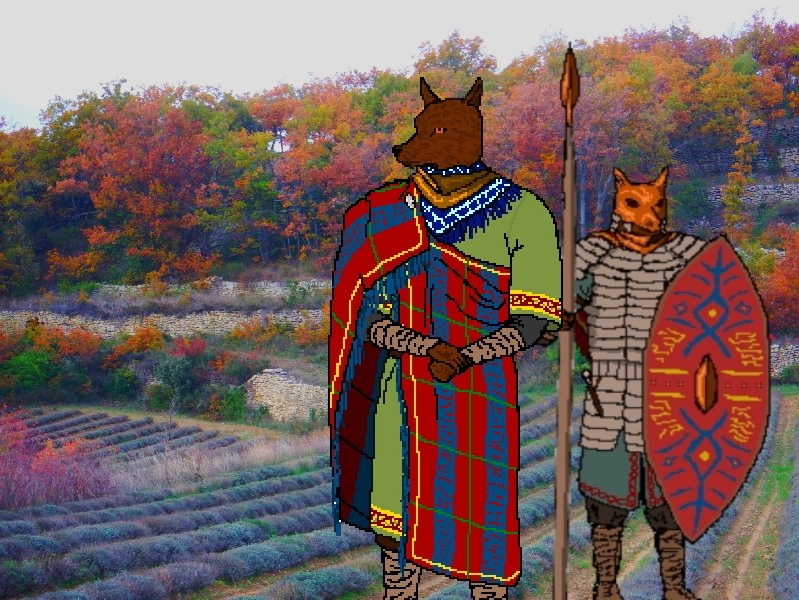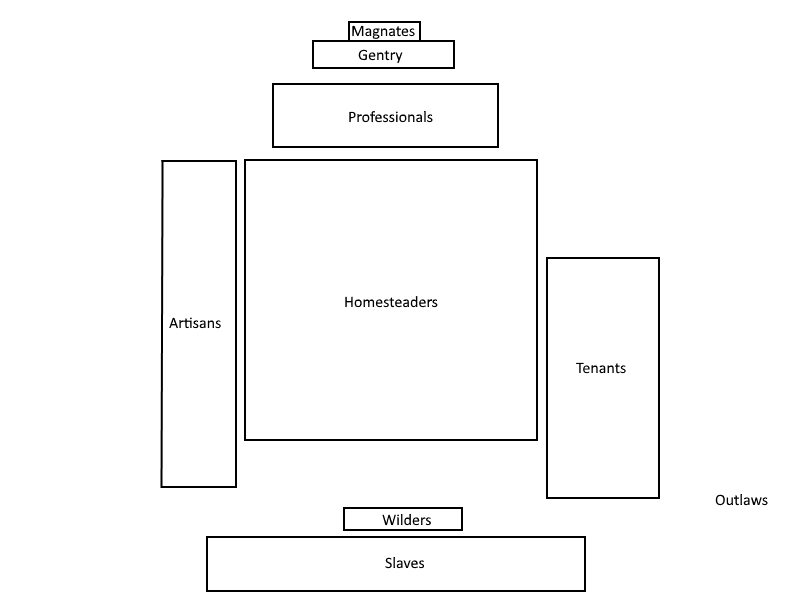Redwolvens
The Redwolvens (Redwolven: Mazuwn) are one of the principle breeds and culture-groups of Wolvenland. Native to Redwolvenland, they are a sedentary civilisation spanning numerous sovereign realms and play a leading role in the geopolitics of the wolvens. Once one of the more primitive and reclusive of the wolven cultures, geography and predatory neighbours have since forced them to develop into one of the foremost civilisations of Wolvenland. For all their quiet longings for the simple life, they have taken up the mantle of heroes and see it as their destiny to spread liberty and justice across Wolvenland and challenge tyrants wherever they may arise.
Included in this culture are the Zhiwtay, Gwahtay, Ohmay, Yetuwn, Wreymuwn, Towsay, Kazuwn, Gepsay, Owruwn and Luwnay. All speak dialects of the Redwolven language, except for the Owruwn (Orrants) who speak Owruwnay, and the Luwnay (Valish), who speak Luwnay. Closely related to the Redwolvens are the Greenwolvens of the Zhawn.
The Redwolven name comes from the colour of their fur, which tends to be ruddy and coppery.
Naming Traditions
Feminine names
Fay, Pwey, Ziyn, Owgh, Loc, Sowin, Leynge, Zhiw, Niwr, Miy, Meyv, Naym, Ghriy, Mew, Nwahv, Yawle, Crawte, Kwitiw, Vringe, Zhawte, Twuw, Liwv, Fwoylo, Miwl, Ziwl, Mewim, Nagiw, Hiwm...
Masculine names
Wrow, Maz, Pwowz, Zuwn, Dwaygo, Ays, Nwaht, Hawr, Kwoh, Wiyum, Osiwr, Daw, Nagawr, Zawr, Zadzhiw, Owlim, Biwm, Daym, Wrigh, Sahbo...
Culture
Major language groups and dialects
Proto-Rovunic >
Proto-Western Rovunic >
Proto-Redwolven >
Redwolven language (Mazuwnay)
Orrant language (Owruwnay)
Valish language (Luwnay)
Culture and cultural heritage
Redwolven society holds to ideals of egalitarianism, harkening to the ways of their hunter-gatherer ancestors rather than the 'civilised vices' such as the rigid hierarchy of the Moonwolvens and the patriarchy of the Northwolvens. The Redwolvens have a dislike of formalised class divisions and prefer to emphasise the unity of the tribe at all levels, though their society is still stratified. Their hierarchy is meritocratic, based on the achievements of individuals (in prestige) and their households (in wealth). Individuals are always expected to distribute their wealth among their household, which forms the most fundamental unit of society.
The typical class system of the Redwolvens (above). Most are homesteaders (farmers who own their house outright) or tenant farmers, while a financial elite called the gentry (wealthy merchants and business tychoons) hold a disproportionate influence. Slaves often make up one-tenth of society. Slavery was adopted only in the Mercantile Period and is a controversial institution, though no abolition movement has yet been able to unseat the highly profitable practice. Slaves among the Redwolvens do, however, have the unique Right of Resale, whereby they can ask the government to purchase and resell them to another owner without questions, to provide incentive for slavemasters not to heavily abuse their slaves. However, corporal punishment of slaves remains widespread despite being illegal.
With tribal welfare being a long-held tenet of their culture, each tribe has a 'charitary' (charitable ministry) concerned with provisions for the poorest in society with taxation from the wealthiest: a feature that has stunted their prosperity in the eyes of the Northwolvens.
The concept of freedom, and respect of personal choice, is fundamental to Redwolven and Greenwolven culture, with individuality being sacred. Wealth is a notable exception to this, with the household expected to support all of its members fairly: to abandon one's household upon gaining prosperity is a serious taboo.
Shared customary codes and values
Wowlay values of peace, empathy, liberty, justice, humility and tradition.
Common Customs, traditions and rituals
Family properties are usually held in kind by all members of the household, unlike in neighbouring cultures where they are held by the eldest wolfess.
Coming of Age Rites
First Wilding: young wolvens must depart into the wilds alone for 9 days to test their wildcrafts and gain their wildname.
Ideals
Gender Ideals
Like in all wolven cultures, various roles exist for each gender, though (like their Greenwolven cousins) the Redwolvens are less comprehensive on this than other cultures. Unlike among the Northwolvens, public life is not restricted between either gender, with wolfards and wolfesses found in most professions. Notable exceptions are the military, which is reserved for males, and nursing, which is reserved for females.
Gender ideals are set by their religion, which holds that males are born in the image of the Great Hunter, as agents of change and zeal while females are born in the image of the Great Healress, as agents of harmony and tenderness.
On the farmstead, works are undertaken by anyone appropriate to the need, but with wolfards mostly occupied in the heavy labours and wolfesses mostly in the housework.
Matrilocality is the normal family structure upon marriage, with husbands joining their wife's household, though it is not shameful for patrilocality to be agreed.
Related Organizations
Remove these ads. Join the Worldbuilders Guild










Comments